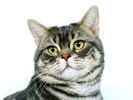
CFA Cattery of Distinction

 The American Shorthair traces its roots back as far as the 17th century. Records indicate that some of the first cats on North America arrived on the Mayflower with the Pilgrims, making them genuine American originals. The cats had been brought along to control the rats and mice that ate the settlers' food and spread diseases, both onboard ship and in the New World. Over the years, their great hunting instincts allowed them to spread far and wide in this country of plenty. But eventually, other breeds were imported and interbreeding diluted the specialness of these hardy cats. That changed late in the 19th century when a group of dedicated cat fanciers chose a short-haired cat to develop and selectively breed as a true representative of America.
The American Shorthair traces its roots back as far as the 17th century. Records indicate that some of the first cats on North America arrived on the Mayflower with the Pilgrims, making them genuine American originals. The cats had been brought along to control the rats and mice that ate the settlers' food and spread diseases, both onboard ship and in the New World. Over the years, their great hunting instincts allowed them to spread far and wide in this country of plenty. But eventually, other breeds were imported and interbreeding diluted the specialness of these hardy cats. That changed late in the 19th century when a group of dedicated cat fanciers chose a short-haired cat to develop and selectively breed as a true representative of America.
By the turn of the 20th century, what was simply called shorthair was again a popular breed and one of only five then recognized by the Cat Fancier's Association. One brown tabby shorthair was sold at the 1896 Second Annual Cat Show at Madison Square Garden for the astronomical sum of $2500. Adjusted for inflation, that's equal to $50,000 today! In 1901, the first pedigreed shorthair registered in the United States was a red tabby male named Belle of Bradford, although as an import from England, he would today be considered a British Shorthair, a separate breed altogether. The first pedigreed shorthair kitten born in the U.S. was a male smoke named Buster Brown. For a while, the breed was known as Domestic Shorthairs and merely tolerated at shows. 1964 saw the breed break through in the show ring when a domestic shorthair named Shawnee Sixth Son became CFA Kitten of the Year. A year later, Shawnee Trademark became CFA Cat of the Year. With these back-to-back successes, it was decided to give the breed a more distinctive name to differentiate them from the common mixed-breed shorthairs. By the 1966 show season, the CFA formally renamed them American Shorthairs. The last great success came thirty years later in 1996 when brown tabby male Sol-Mer Sharif also became CFA Cat of the Year.
Today, the breed is recognized by all of the cat associations including the CFA, the TICA, AACE
The American Shorthair is not the mouser its ancestor was. With its adorable face and calm, loving temperament, it will instead become a true member of your family.
American Shorthairs are every bit as sweet as they look, with delightful personalities and even temperaments. Their self-sufficiency makes them ideal for the busy, single owner who is at work all day. However, they're also excellent with families, being gentle and patient with children and other pets, even dogs. Should children become too rambunctious, an American Shorthair will often simply walk away and come back when things calm down.
They are a happy medium in demeanor. At the extremes of personality are purebred Siamese and Persians. Siamese have a reputation as needing more attention. Persians tend to be very docile, but of course need a daily regimen of brushing and combing through their long coats.
Most American Shorthairs prefer to make their own way on the ground rather than be picked up. Chalk it up to their independent-minded forebears. Given enough time and love, though, many do become faithful lap-cats. They are quiet cats, with melodious, little voices that are reminiscent of babies.
 The first thing about a good American Shorthair that catches your eye is the broad face with the large but not oversized eyes and ears. In dimmer light, the pupils dilate completely and you can get lost in these eyes. The nose is relatively short and wide, giving good spacing to the eyes. The ears are also larger than most cats. It's this sweet, open, innocent expression that instantly captures the heart of many prospective owners and garners ribbon after ribbon in the show ring. This cat is ideal for those seeking a purebred cat without extremely long or short features.
The first thing about a good American Shorthair that catches your eye is the broad face with the large but not oversized eyes and ears. In dimmer light, the pupils dilate completely and you can get lost in these eyes. The nose is relatively short and wide, giving good spacing to the eyes. The ears are also larger than most cats. It's this sweet, open, innocent expression that instantly captures the heart of many prospective owners and garners ribbon after ribbon in the show ring. This cat is ideal for those seeking a purebred cat without extremely long or short features.
Healthy adult males weigh from 11 to 15 pounds, while adult females are smaller at 8 to 12 pounds. It's easy to distinguish an adult male from an adult female - males have pronounced jowls, or rather chubby cheeks.
The body is strong and muscular, what's called a "cobby" build in the cat fancy. Their physique has been compared to that of a trained gymnast - neither excessively lithe nor stocky. The tail is medium thick with a graceful taper. The short hair still retains its weather resistance and is easily maintained with weekly brushing.
The earliest shaded American Shorthairs were registered in 1913 and they regularly competed against the brown and silver tabbies in 1951, making them one of the earliest colors recognized by CFA. By the mid-1960's, shaded silvers attained their current position as the 3rd most popular color registered in CFA. This exquisite color peaked in popularity in the late 1970's, but proved hard to breed for show purposes, so despite its popularity as a strikingly beautiful pet, the color pattern almost disappeared from the breed in the late 1980's.
An American Shorthair can live an average of 15 to 20 years, even longer for some lucky cats and their owners. This is a long-term commitment for both feline and human. They reach sexual maturity at about seven months and adulthood at three to four years. They may start to show some signs of old age at about seven years of age but even so usually have no serious health problems, requiring nothing more than a yearly checkup at the veterinarian.
Wednesday, November 19, 2025
Copyright © 1994 - 2025 Carol W. Johnson,
Melodygarden Cattery.All Rights Reserved.
All photographs are copyrighted by the respective photographers
and may not be reused without their express written permission.